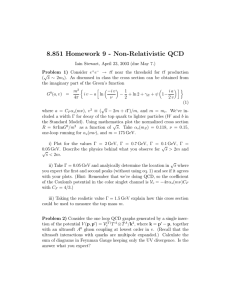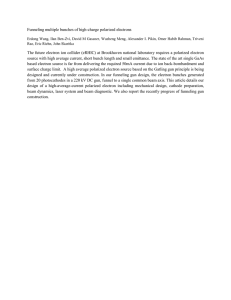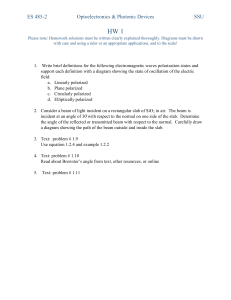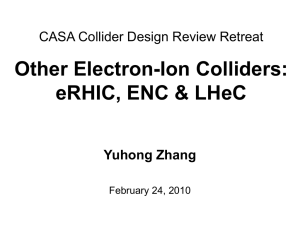Thomas Roser - eRHIC R D and realization plan
advertisement
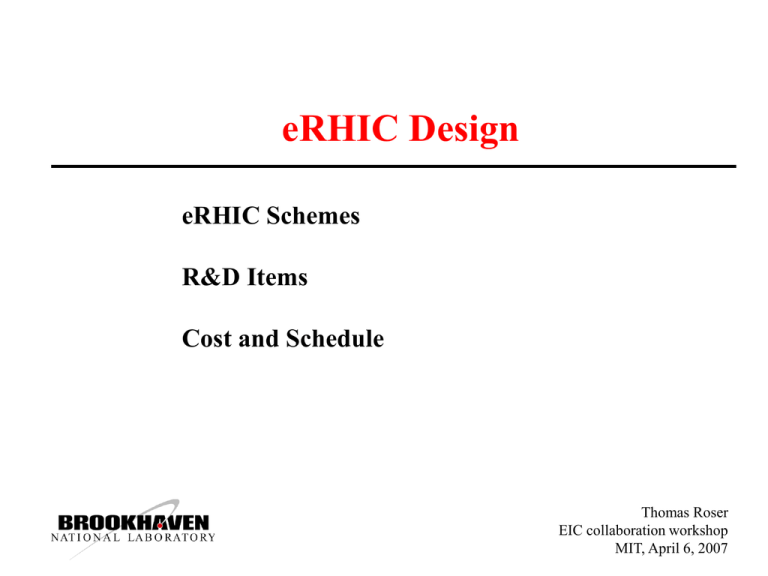
eRHIC Design eRHIC Schemes R&D Items Cost and Schedule Thomas Roser EIC collaboration workshop MIT, April 6, 2007 eRHIC Scope RHIC Electron accelerator p Polarized leptons 3-20 Gev Polarized protons 50-250 Gev ee+ 70% beam polarization goal Heavy ions (Au) 50-100 Gev/u Polarized light ions (3He) 167 Gev/u eRHIC Integrated electron-nucleon luminosity of ~ 50 fb-1 over about a decade for both highly polarized nucleon and nuclear (A = 2-208) RHIC beams. 50-250 GeV polarized protons up to 100 GeV/n gold ions up to 167 GeV/n polarized 3He ions Two accelerator design options developed in parallel (2004 Zeroth-Order Design Report): ERL-based design (“Linac-Ring”; presently most promising design): Superconducting energy recovery linac (ERL) for the polarized electron beam. 33 cm-2s-1 with potential for even higher luminosities. Peak luminosity of 2.6 10 R&D for a high-current polarized electron source needed to achieve the design goals. Ring-Ring option: Electron storage ring for polarized electron or positron beam. 33 cm-2s-1. Technologically more mature with peak luminosity of 0.47 10 Decision on what to build to supply polarized leptons will be driven by a number of considerations, among them experimental requirements, cost and timeline. e-cooling (RHIC II) PHENIX Main ERL (3.9 GeV per pass) Peak Luminosity, 1033 cm-2s-1 ERL-based eRHIC Design 3 3GeV(e)-250GeV(p) 2 1.5 1 0.5 3GeV(e)-50GeV(p) 20GeV(e)-50GeV(p) 0 20 30 40 50 STAR 60 70 80 90 100 110 120 130 140 150 Center-Of-Mass Energy, GeV e+ storage ring Four e-beam 5 GeV - 1/4 RHIC circumference passes 20GeV(e)-250GeV(p) 2.5 Compact recirculation loop magnets Electron energy range from 3 to 20 GeV Peak luminosity of 2.6 1033 cm-2s-1 in electron-hadron collisions; high electron beam polarization (~80%); full polarization transparency at all energies for the electron beam; multiple electron-hadron interaction points (IPs) and detectors; 5 meter “element-free” straight section(s) for detector(s); ability to take full advantage of electron cooling of the hadron beams; easy variation of the electron bunch frequency to match the ion bunch frequency at different ion energies. 5 mm 5 mm 5 mm 5 mm ERL-based eRHIC Parameters Electron-Proton Collisions Electron-Au Collisions High energy setup Low energy setup High energy setup p e p e Au e Au e Energy, GeV 250 20 50 3 100 20 50 3 Number of bunches 166 Bunch spacing, ns 71 71 71 71 71 71 71 71 Bunch intensity, 1011 (109 for Au) 2.0 1.2 2.0 1.2 1.1 1.2 1.1 1.2 Beam current, mA 420 260 420 260 180 260 180 260 6 115 6 115 2.4 115 2.4 115 Rms emittance, nm 3.8 0.5 19 3.3 3.7 0.5 7.5 3.3 b*, x/y, cm 26 200 26 150 26 200 26 60 0.015 2.3 0.015 2.3 0.015 1.0 0.015 1.0 Rms bunch length, cm 20 1.0 20 1.0 20 1.0 20 1.0 Polarization, % 70 80 70 80 0 0 0 0 95% normalized emittance, πμm Beam-beam parameters, x/y 166 166 Low energy setup 166 Peak Luminosity/n, 1.e33 cm-2s-1 2.6 0.53 2.9 1.5 Aver.Luminosity/n, 1.e33 cm-2s-1 0.87 0.18 1.0 0.5 Luminosity integral /week, pb-1 530 105 580 290 Ring-Ring eRHIC Design 5 – 10 GeV e-ring 5 -10GeV full energy injector RHIC e-cooling (RHIC II) Based on existing technology Collisions at 12 o’clock interaction region 10 GeV, 0.5 A e-ring with 1/3 of RHIC circumference (similar to PEP II HER) Inject at full energy 5 – 10 GeV Polarized electrons and positrons eRHIC R-R: Full Energy Injection Options Polarized Electron 200 MeV Source Copper Linac, SLAC type cavities Polarized Electron 200 MeV SC Linac, Tesla type cavities Source 10 GeV 8 GeV 6.7 GeV 2 GeV 4 GeV 2 GeV 3.3 GeV 10 GeV 6 GeV 8.3 GeV Positron Source 4 GeV 10 1.7 GeV 200 MeV 200 MeV 0 5 GeV 50 Positron Source 3.3 GeV 100 150 200 250 275 m Recirculating NC linac 0 10 50 100 150 200 250 275 m Recirculating SC linac Extraction 5 - 10 GeV • Injection of polarized electrons from source • Ring optimized for maximum current Injection 0.5 GeV Positron Source 0 10 50 100 Polarized Electron Source, 20 MeV 150 m • Top-off Figure 8 booster synchrotron, FFAG or simple booster Ring-Ring eRHIC Parameters High energy setup Energy, GeV GeV Number of bunches Low energy setup p e p e 250 10 50 5 165 55 165 55 71 71 71 71 Bunch spacing ns Particles / bunch 1011 1.00 2.34 1.49 0.77 Beam current mA 208 483 315 353 95% normalized emittance p mm·mrad 15 Emittance ex nm 9.5 53.0 15.6 130 Emittance ey nm 9.5 9.5 15.6 32.5 bx* m 1.08 0.19 1.86 0.22 by* m 0.27 0.27 0.46 0.22 Beam-beam parameter xx 0.015 0.029 0.015 0.035 Beam-beam parameter xy 0.0075 0.08 0.0075 0.07 5 Bunch length sz m 0.20 0.012 0.20 0.016 Polarization % 70 80 70 80 Peak Luminosity 1033 , cm-2s-1 0.47 0.082 Average Luminosity 1033 , cm-2s-1 0.16 0.027 Luminosity Integral /week pb-1 96 17 eRHIC Ion Beam RHIC is the world’s only collider of high-energy heavy ion (for now) and polarized proton beams. 100 GeV proton beams with ~ 65% polarization operational First test at 250 GeV reached ~ 45% polarization First high energy stochastic cooling demonstrated in RHIC Electron cooling under development for RHIC II (x10 luminosity). Also needed/beneficial for eRHIC with same requirements as RHIC II Presently RHIC operates with 111 bunches of 1.4 x 1011 protons. Successful test of 111 bunches of 3 x 1011 protons at injection. eRHIC design is 166 bunches of 2 x 1011 protons. Development under way for polarized 3He beams from the new RHIC ion source EBIS Interaction Region Design Yellow ion ring makes 3m vertical excursion. Design incorporates both normal and superconducting magnets. Fast beam separation. Besides the interaction point no electron-ion collisions allowed. Synchrotron radiation emitted by electrons does not hit surfaces of cold magnets (Red) electron beam magnets (Blue) ion ring magnets Detector (Yellow) ion ring magnets IR Design Schemes Distance to nearest magnet from IP Beam separation Magnets used Hor/Ver beam size ratio Ring-ring, l*=1m 1m Combined field quadrupoles Warm and cold 0.5 Ring-ring, l*=3m 3m Detector integrated dipole Warm and cold 0.5 Linac-ring 5m Detector integrated dipole Warm 1 No crossing angle at the IP Linac-ring: larger electron beta*; relaxed aperture limits ; allows round beam collision geometry (the luminosity gains by a factor of 2.5). Detector integrated dipole: dipole field superimposed on detector solenoid. Main R&D Items (other than engineering and costing) Electron beam R&D for ERL-based design: High intensity polarized electron source (for polarized beams!) 2 Development of large cathode guns with existing current densities ~ 50 mA/cm with good cathode lifetime. (MIT research proposal) Energy recovery technology for high energy and high current beams Thorough beam tests with the BNL test ERL based on the 5-cell cavity studying loss tolerances and the cavity protection systems. Development of compact recirculation loop magnets Design, build and test a prototype of a small gap magnet and its vacuum chamber. Evaluation of electron-ion beam-beam effects, including the kink instability and e-beam disruption Realistic beam-beam simulations. Electron beam R&D for the ring-ring design: No major R&D items Main R&D items for ion beam for both designs: 3 Polarized He production (EBIS) and acceleration 3 Develop EBIS as spin-preserving ionizer of optically pumped pol. He gas 3 Evaluation of depolarization due to high anomalous magnetic moment of pol. He beams during acceleration in AGS and RHIC Other R&D R&D for specific experimental programs: High precision ion beam polarimeter • Improve absolute polarization accuracy from about 5% to 1% R&D to further increase eRHIC luminosity: Increase number of ion bunches from 166 to 333 • Electron clouds with 30 ns ion bunch spacing (LHC has 25 ns bunch spacing) • Injection kicker development • Higher current of ERL Optical stochastic cooling of high energy proton beam • Proof of principal experiment proposed at Bates Beam-beam compensation • The focusing effect of the colliding electron beam on the ion beam could be compensated with ion-ion collisions Ring-ring preliminary cost estimate (2007$) Electron ring : 132 M Interaction region 9M Injector (warm recirculating linac, incl. source): 113 M Installation: 16 M Civil construction: 21 M ----------------------------------------------------------------------------------------Total: 291 M ----------------------------------------------------------------------------------------With PED/EDIA (20%), Contingency (30%) and G&A (15%): Total Equipment Cost (TEC): 523 M Detector allowance: 103 M Pre-ops, R&D: 72 M ----------------------------------------------------------------------------------------Total Project Cost (TPC): ~ 700 M ----------------------------------------------------------------------------------------- Linac-ring preliminary cost estimate (2007$) 4 GeV superconducting linac incl. source: 111 M 5 pass recirculation loops (5 x ~15M): 77 M Interaction region: 9M Installation: 26 M Civil construction: 21 M Cryogenics: 41 M Switch yards: 21 M Positron capability: 15 M ----------------------------------------------------------------------------------------------Total: 321 M ----------------------------------------------------------------------------------------------With PED/EDIA (20%), Contingency (30%) and G&A (15%): Total Equipment Cost (TEC): 577 M Detector allowance: 103 M Pre-ops, R&D: 72 M ----------------------------------------------------------------------------------------------Total Project Cost (TPC): ~ 750 M ------------------------------------------------------------------------------------------------ Straw-man technically driven schedule in 2007$ FY10 FY11 FY12 R&D 5 7 5 CDR 3 PED/EDIA FY13 FY14 FY15 31 Total 17 62 23 62 115 103 144 Pre-ops 8 FY17 3 Construction TPC FY16 38 67 84 Incremental operations costs: ~ 50 M (2007$) 103 144 144 111 564 16 35 51 161 146 752 Summary Two versions for eRHIC have been developed: Ring-ring: lower risk (ready to go), lower luminosity performance, 10 GeV e Linac-ring: higher risk (new concept), higher luminosity performance, 20 GeV e Preliminary cost estimate is similar. Decision on what to build to supply polarized leptons will be driven by a number of considerations, among them experimental requirements, cost and timeline. Modest R&D over the next five years will reduce technical risk, especially for linac-ring option. There are phasing possibilities for both options.

